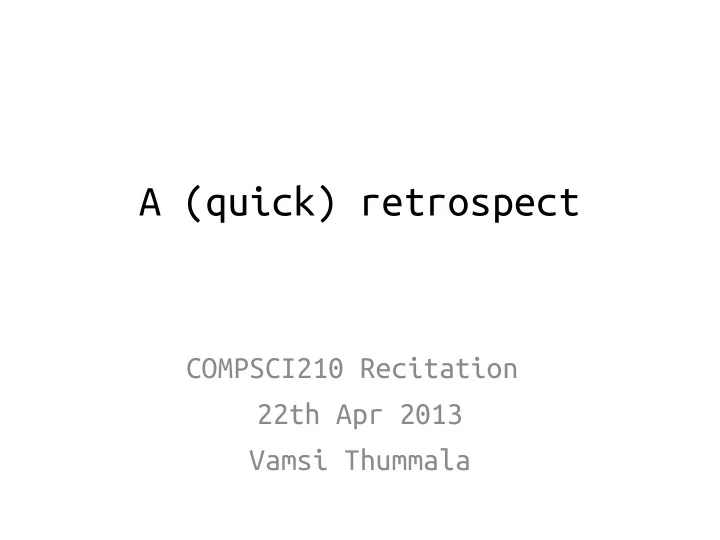

A (quick) retrospect COMPSCI210 Recitation 22th Apr 2013 Vamsi Thummala
Latency Comparison L1 cache reference 0.5 ns Branch mispredict 5 ns L2 cache reference 7 ns 14x L1 cache Mutex lock/unlock 25 ns Main memory reference 100 ns 20x L2 cache, 200x L1 cache Compress 1K bytes with Zippy 3,000 ns Send 1K bytes over 1 Gbps network 10,000 ns 0.01 ms Read 4K randomly from SSD 150,000 ns 0.15 ms Read 1 MB sequentially from memory 250,000 ns 0.25 ms Round trip within same datacenter 500,000 ns 0.5 ms Read 1 MB sequentially from SSD 1,000,000 ns 1 ms 4X memory Disk seek 10,000,000 ns 10 ms 20x data center roundtrip Read 1 MB sequentially from disk 20,000,000 ns 20 ms 80x memory, 20X SSD Send packet CA->Netherlands->CA 150,000,000 ns 150 ms
Abstractions: Beauty and Chaos ✔ Context ✔ Attribute ✔ Component ✔ Label ✔ Connector ✔ Principal ✔ Channel ✔ Reference Monitor ✔ Event ✔ Subject ✔ Entity ✔ Object ✔ Identity ✔ Guard ✔ App ✔ Service ✔ Signature ✔ Module
Case Study: Unix • Example program: cat compsci210.txt | wc | mail -s "word count" chase@cs.duke.edu • Component: Executable program • Context: Process that executes the component • Connector: Pipes • In general, an OS: – Sets up the context – Enforces isolation – Mediates interaction
Case Study: Unix protection • Excerpt from “Notes on Security”: The Unix example exposes some principles that generalize to other systems. In general, all of the OS platforms we consider execute programs (or components, or modules) in processes (or some other protected context, or sandbox, or protection domain) on nodes linked by communication networks. A platform's protection system labels each running program context with attributes representing “who it is”, and uses these labels to govern its interactions with the outside world. Do Reference Object Principal operation monitor Source Request Guard Resource
More on Protection Do Reference Object Principal operation monitor Source Request Guard Resource Principal may do Operation on Object Chase Read dFile Alice Pay invoice 4325 Account Q34 Bob Fire three rounds Bow gun Authentication: Who sent a message? Authorization: Who is trusted? • Principal: Abstraction of “who” • People: Chase, Alice • Services: DeFiler Principles for Computer System Design, Turing Award Lecture, 1983
Case Study: Android • What is a component? – Types of components? • What is an App? • What is a Binder service? • What is a Zygote? – Why does Andorid context needs just a fork() but not exec()? • How does Android protection differs from Unix?
Prof. Chase slides
Concurrency • Mutual exclusion – Lock/mutex; too much milk • Monitor – CV + mutex; scheduling threads; ping-pong • Semaphore – Numeric resources; producer-consumer soda example • EventBarrier – Scheduling in phases/batches; Elevator • Implement one primitive in terms of the other – E.g., Implement a Semaphore using only a monitor
Performance • Single node OS – Latency/Response time – Throughput • Internet Scale systems not scalable – Consistency scalable – Availability cost – Partition Tolerance – Incremental scalability capacity
Servers Under Stress saturation Ideal Response Response time rate (throughput) Overload Thrashing Collapse Request arrival rate (offered load) Load (concurrent requests, or arrival rate) [Von Behren]
Crypto: Concept checkers • What is the basic assumption that cryptography relies on? • What is a hash/finger print/digest? • What is a digital signature? • Symmetric vs Asymmetric crypto • What is a nonce? • What is a security/treat model? • Type of attacks and defenses
Cumulative Distribution Function (CDF) 80% of the requests have “Tail” of 10% of requests with response time r with x1 < r < x2 . response time r > x2 . 90% quantile A few requests What’s the have very long mean r? response times. 50% median 10% quantile x1 x2 Understand how the mean (average) response time can be misleading.
SEDA Lessons • Means/averages are almost never useful: you have to look at the distribution. • Pay attention to quantile response time. • All servers must manage overload. • Long response time tails can occur under overload, and that is bad. • A staged structure with multiple components separated by queues can help manage performance. • The staged structure can also help to manage concurrency and and simplify locking.
Fischer-Lynch-Patterson (1985) • No consensus can be guaranteed in an asynchronous system in the presence of failures. • Intuition: a “failed” process may just be slow, and can rise from the dead at exactly the wrong time. • Consensus may occur recognizably, rarely or often. Network partition Split brain
consistency C CA: available, and CP: always consistent, even in a partition, but a reachable consistent, unless C-A-P replica may deny service if it there is a partition. is unable to agree with the choose two others (e.g., quorum). A P AP: a reachable replica Availabilit Partition-resilience provides service even in y a partition, but may be inconsistent.
Coordination in Distributed Systems • Master coordinates, dictates consensus – e.g., lock service – Also called “primary” • Remaining consensus problem: who is the master? – Master itself might fail or be isolated by a network partition. – Requires a high-powered distributed consensus algorithm (Paxos).
Recommend
More recommend